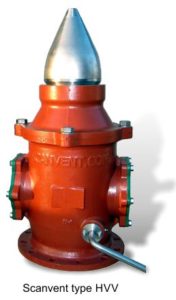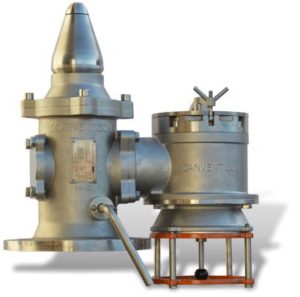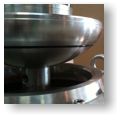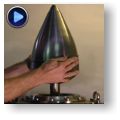High velocity vent in a patented non-oscillating version to ISO 15364:2007 / MSC Circ. 677 and ISO 16852
 The Scanvent high velocity valve is the result of dedicated research into creating the ideal compromise between loss of tank vapour and non-oscillating behavior, all in a simple package that appeals to low maintenance. It features a combination of magnet power and air breaks, which are unique and patent applied for. It is truly non-oscillating as it complies with the two second no-metal-to-metal contact definition from ISO 15364:2007. At the same time, and this is the real accomplishment, it does not emit tank vapour to atmosphere unless the set-pressure is reached, at which point it will only emit excess pressure, unless a true emergency is happening when the primary full capacity unit will open.
The Scanvent high velocity valve is the result of dedicated research into creating the ideal compromise between loss of tank vapour and non-oscillating behavior, all in a simple package that appeals to low maintenance. It features a combination of magnet power and air breaks, which are unique and patent applied for. It is truly non-oscillating as it complies with the two second no-metal-to-metal contact definition from ISO 15364:2007. At the same time, and this is the real accomplishment, it does not emit tank vapour to atmosphere unless the set-pressure is reached, at which point it will only emit excess pressure, unless a true emergency is happening when the primary full capacity unit will open.
Normally, the blow-down (difference between opening and re-seating pressure) must be larger than the pressure drop over the vent line, which can render the design useless from the point of a VOC Management Plan as huge volumes of cargo will boil-off and be emitted for no purpose to atmosphere. INTERTANKO and others have estimated the VOC loss on the crude carrier to equal 0.25% of the cargo. The Scanvent valve can reduce VOC loss for all practical purposes to nil during voyage.
The vent features two discs: a small spring loaded one for thermal variation. It creates a rising pressure in level with rising capacity, i.e., it is a modulating valve. It will only emit what’s necessary in order to maintain tank pressure at or just above it’s set-pressure. The main valve, however, is a full-lifting type due to its magnet characteristics. To render it non-oscillating and without a drastic blow-down, it features a novel air break. As an example, it will open full at set-pressure 0.21 bar and re-seat at 0.15 bar. A comparative competitor valve for the same pipe length would not re-seat until the tank pressure is down at 0.10 bar and that’s what would happen every time the competitor valve opens.
From a practical point of view, the valve’s wear and tear is for all practical purposes limited to the small thermal valve, which has a stroke of 1-2 mm and a moving weight of a few kg. In other words: seat/disc wear and pitting is reduced to a mere fraction of the usual level, where grinding/replacement can be necessary every 1-2 years. When overhaul is necessary, the entire inside trim can be lifted out in one lot, replaced, and the crew can easily remove seats and discs for repair or replacement. There is no need to involve the factory or to use expensive service engineers.






